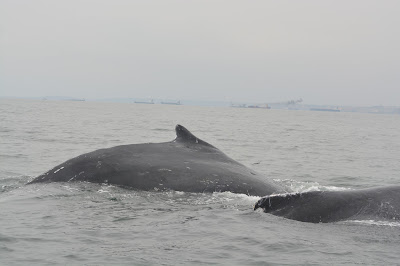September 17, we returned from 3 weeks holiday in Portugal, a first visit for both of us.
We left Angola via TAP (Portugal airlines) and arrived in Lisbon, capital city, on August 24. Most of the major expeditions from the Golden Era departed from Lisbon including Vasco da Gama who travelled to India in 1497. The 16th century was Lisbon's golden era: the city was the European hub of commerce between Africa India, the Far East and later, Brazil and acquired great riches by exploiting the trade in spices, slaves, sugar, textiles and other goods. Lisbon is the oldest city in western Europe, predating London, Paris and Rome. Lisbon suffered many earthquakes and a major one in 1755 destroyed 85% of the city's buildings. We stayed for one week in the oldest area of Lisbon, Alfama. With narrow and very hilly streets, the best way to get around was by foot or catching one of the many electric trams.
 |
| Miradoura Alfama (viewpoint near where we stayed) |
 |
| Cruise liner in port from same miradoura |
 |
| Rua Escola Gerais...our street with tram coming... |
With such narrow streets, the tram and other drivers need patience in negotiating the roads. As we arrived at our apartment, our taxi driver quickly helped us with our luggage while the rest of the traffic waited (reasonably) patiently behind us.
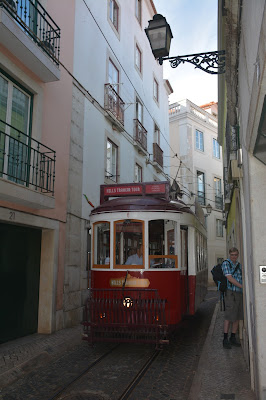 |
| ...watch out! |
 |
| Enjoying Portuguese soup |
With mostly hot weather (the first evening had a little cool breeze hence the restaurant-provided pashmina) we sat outside for meals and enjoyed many local cervejas! (beer). I enjoyed an old favourite of Chandy a mix of beer and lemonade. We didn't get to really appreciate the traditional salted cod (Bacalhau) as the Portuguese do but did savor most other seafood, also tapas including charcoaled peppers and olives.
 |
| BMW scooter for Ian or Jill |
 |
| Lisbon Cathedral |
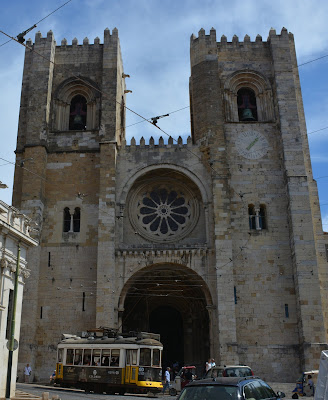 |
| Typical sight of the yellow no. 28 tram in front of Cathedral |
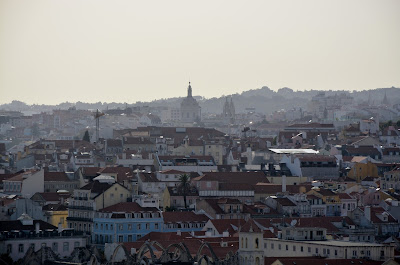 |
| Lisboa vista |
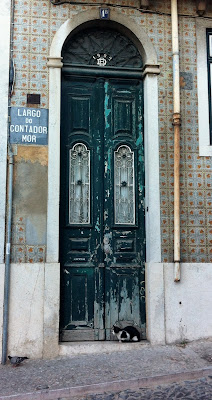 |
| I love cats. Cats love pigeons. |
 |
| Statue of King Jose 1st in front of Triumphal Arch |
 |
| Arco da Rua Augusta |
The Rua Augusta Arch stands on Commerce Square in central Lisbon to commemorate the city's reconstruction following the 1755 earthquake. Statue of King José I, (1775). The King on his horse is symbolically crushing snakes on his path.
 |
| Cup in hand everywhere |
 |
| Creative Portuguese |
 |
| Jeroen heading to Jeronimo's |
Jeronimos Monastery , inaugurated in 1495 was completed in 1601 replacing the original church dedicated to Santa Maria de Belem. Monks of the military-religious Order of Christ prayed for the eternal soul of the King and provided assistance to seafarers in transit. Both the monastery and nearby Belem Tower were awarded World Heritage Site status in 1983.
 |
| Mosteiro dos Jeronimos |
 |
| The Cloisters created from gold coloured limestone |
 |
| Inside Jeronimos |
 |
| Altar paintings |
 |
| Beautiful rope detailing |
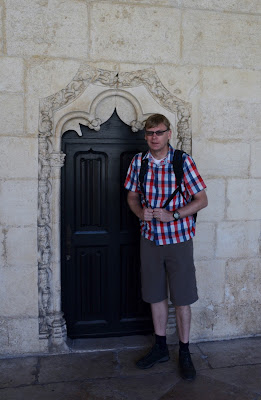 |
| Jeronimo Monks took confession from travelling sailors |
 |
| A welcome break in the shade |
The monastery hosted a Portuguese Discovery time-line.. I learned that in 1547 Portuguese doctor Amato Lusitano examined the valves of human veins for the first time, paving the way for the study of blood flow.
 |
| Many designs |
 |
| Jesus Feeding the 5000 |
Our friend Filipa had told us we MUST visit the nearby café to experience the traditional Portuguese custard tarts (Pasteis das natas) so we found the place and dug in. Delish! We were told we had to have 2 each.
 |
| Pastel da nata x2 |
After we enjoyed our morning tea and Jeroen his coffee, we discovered that we had not gone to the right place for our treats! The correct venue was a previous sugar refinery which now serves the local pastry. So we decided we had to honour Filipa and go there as well...we had to!
 |
| Luxury till |
 |
| Near the kitchen of Pasteis de Belem |
The soft egg custard filling, encased in a light-and-crunchy-pastry tart is created following a 200 year old recipe.
 |
| Yes, more custard tarts! |
Near the Monastery and Pasteis de Belem is the Tower of Belem, The tower which was commissioned by King John II to be part of a defence system at the mouth of the Tagus river and a ceremonial gateway to Lisbon.
The tower was built in the early 16th century and is a prominent example of the Portuguese Manueline style.
 |
| Torre de Belem |
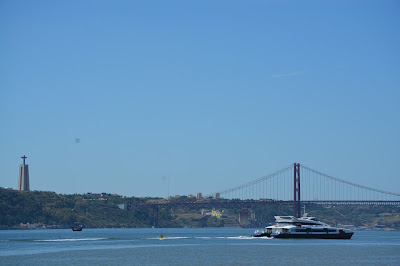 |
| View from Tower of Cristo Rei (Christ King statue) and 25 de Abril bridge |
The bridge was completed in 1966 and renamed Ponte 25 de Abril following the revolution.
 |
| Someone having a nap |
 |
| Portuguese street art |
 |
Beautiful tiling everywhere
|
 |
| Yellow and Orange tiling on a building in Chiado |
 |
| Music of Fado |
Typical of Portugal, with mournful and lyrical tunes, the soul music called Fado can heard in many streets of Lisbon.
 |
| Castelo de Sao Jorge |
The Moorish Castle of St George overlooks the historic area of Lisbon where we stayed in Alfama. The first fortification was erected in 48 BC, when Lisbon was classified as a Roman municipality.
 |
| View of the original archaeological site |
 |
| Overlooking the city |
 |
| View from Castle |
 |
| Another hot day |
 |
Antique Discoverers Map
|
 |
| Historic patterns of Portugal tiling |
 |
| Peacock showing off |
 |
| Jeroen up high |
 |
| Gelato Therapy |
We loved this window display showcasing the Casa de Gelato Therapy and it's icecream contents.
 |
| The Music Man on Praca do Comercial |
 |
| Vying for road space - cars, trams and tuk tuks. |
 |
| Tiling at the Lisbon Train station, Rossio. |
 |
| There were plenty of tiles for me to view while I waited for Jeroen...read on! |
One of the most famous trips from Lisbon is to the village of Sintra. Jeroen and I trekked to the Rossio station to find a train almost leaving. Jeroen jumped on board and as he turned to me, the doors closed between us! To the horror of the other travellers and my silent panic, the train took off. With no money, no map, no phone, no ticket, no water or way of knowing if and when Jeroen would come back I decided against getting on the train and completely miss each other travelling up and down the Lisbon-Sintra line looking for each other. So, with only the camera and thankfully my reading glasses, I stayed put at the station for 3 hours and thankfully, Jeroen returned and we finally set out for a great afternoon in Sintra. Moral of the story: always travel with a bit of money, and a plan of where to meet/connect if you get separated.
We enjoyed two half day trips from Lisbon to Sintra and Cascais.
Sintra is a small Portuguese village set in hills 25kms to the west of Lisbon and is one of the top tourist destinations in Portugal. With Moorish Castle, Palaces and narrow, windy roads amongst much greenery, we enjoyed a peaceful afternoon, despite the morning mis-start. The Pena Palace set atop a hill in lush parklands was designed during the 19th century by an eccentric king who championed the arts and wished his summer palace to reflect that of an opera. It sure does look like it with so much colour, varying architectural styles and flamboyance.
 |
| Pena Palace (web photo) |
 |
| Palacio da Pena |
 |
| View from the Castle of an unnamed soldier |
 |
| Palace kitchen with 3 ovens for banquet preparation |
 |
| Jeroen in the Noble Hall |
 |
| In the Cloisters |
 |
| View over the Sintra Hills |
 |
| Resting after an adventurous day |
 |
| Sintra Village |
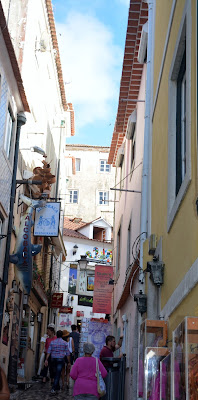 |
| Wandering through the quaint village of Sintra |
 |
| Having a chat |
This lovely woman clearly enjoys chatting with tourists from her kitchen window.
 |
| Moors Castle |
The Moors Castle is a partially restored castle that dates from the 9th century and was built by the North Africa Moors to protect the fertile lands of Sintra. The castle was a significant victory for the 12th century Christian Crusaders but soon fell into disrepair as Lisbon was chosen as the early capital.
Cascais is a former fishing village 30km west of Lisbon.
 |
| Lighthouse and House of Santa Maria |
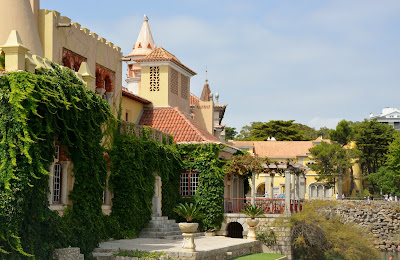 |
| Strolling around Cascais |
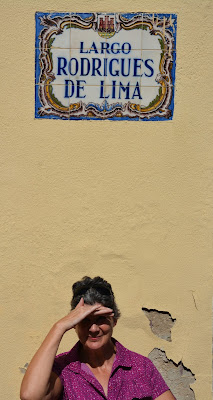 |
| Thinking of Lima Bean |
On the day we visited Cascais hosted the Annual Portuguese Car Festival. Lots of pristine vintage and classic cars...thinking of you Dad and Liam. How many can you name?
 |
| A Dutchie and oldies |
 |
| Glad you don't have to chase baddies in this Wade |
 |
| Will he fit inside? |
 |
| Colourful houses of Cascais |
After our time in Lisbon we rented a car and drove to Coimbra, via Obidos. All of Obidos has been declared a national monument. It is known as the "Wedding Present Town" because it was a gift King Dinis gave to Queen Isabel on their wedding day in 1282, and also what make it one of Europe's most romantic medieval villages are its incredibly picturesque cobblestone streets lined with colourful houses filled with geraniums and bougainvillea, Gothic doorways and windows, whitewashed churches, flowerpots and dazzling tiles -- all encircled by the walls of a 12th century, castle.
 |
| Entranceway to Obidos |
The Main Street of Obidos leads on from this entrance of beautiful tiling. Many shops were selling chocolate pots containing a shot Ginjinh which is a portuguese liqueur made by infusing
ginja berries, (sour cherry) in alcohol and adding sugar together with other ingredients.
 |
| Rua Direita (main street) |
 |
| Flowering Bougainvillea everywhere |
 |
| The fortified city |
 |
Cat with home
|
 |
| Igreja de Santa Maria |
The high concentration of churches and chapels is due to the important status Obidos had with the Portuguese nobility. Originating in 12th century the Santa Maria Church is of significance to early Portuguese history as it was the location of the wedding of King Afonso V (age 10) to his betrothed cousin Isabel (age 8) in 1444.
 |
| Soulful tunes |
 |
| Street tooties |
After an afternoon exploring Obidos, we set off to Central Portugal's 3rd largest city, Coimbra. We stayed in Cidade Alta (high city) - these are photo's from where we stayed.
 |
| A welcome Port and Pastel de nata on our balcony |
 |
| The city prison |
 |
| Lounge view...so nice to be able to open the windows |
 |
| And a delish breakfast |
Coimbra is one of Portugal's oldest cities - it already was an important municipality in Roman times.
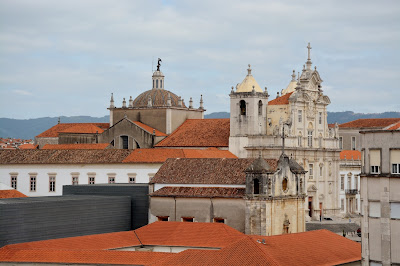 |
| Coimbra city |
 |
| Vendors |
 |
| Crafty Coimbra |
It was the capital of the country from 1139 to 1256 and its university was founded in 1290.
 |
| Entrance to Coimbra University |
 |
| Door to the Library |
The University library, built in early 1700 is a stunning (what I now know to be) Baroque style. As we were unable to take photographs, this one is from the net.
 |
| Biblioteca Joanina |
A curious fact regarding the preservation of its books: the library still contain tiny colonies of bats which roots
behind shelves - a small price to pay for the control of book predators. Every day before closing the
library, an employee covers the tables with leather linens and, before the
opening, he removes them and cleans the floor.
 |
| Uni clock |
Coimbra Cathedral, built post 1139.
 |
| Inside the Se |
 |
| Cathedral doors |
Following 2 nights in Coimbra, we headed to Porto in the North. Home to Tawny Port (and others) and Filipa's home town.
We stayed for one week in downtown Porto, in the area of Bolhau. Bolhau Market across the road from our apartment dates back to 1850.
 |
| Mercado Bolhau |
 |
| Chic shops |
 |
| Porto Cathedral |
 |
| A Cathedral wedding |
The day we visited, there were 5 weddings scheduled in the Cathedral.
While in Porto we were blessed to have our Luanda friends as neighbours for a few nights. Unbeknownst to us, Henriette and Tako had booked to visit Porto and we ended up staying on the same street, one door apart!
 |
| Porto dinner |
We enjoyed an evening together including dinner and an open air orchestral performance. Henriette and Tako have now left Luanda and they will be missed terribly.
 |
| Bye bye |
 |
| St Francisco church |
400kg of gold is said to have been poured into St Francisco church by its patrons in order to secure their place in Heaven. When Napoleon conquered Oporto, he reportedly used the church, in all its opulence, as a stable for his horses.
 |
| Barbearia Santo Antonio |
As Jeroen needed a haircut, we visited this quaint little barber in porto. The barbers and their equipment were all antique! I didn't get to ask why there is a photo of Ronan Keating on the bench...
 |
| Jeroen with Ronan at the barbers |
 |
| Porto craftsman |
 |
| Boat shed on the River Douro |
 |
| Button Bike |
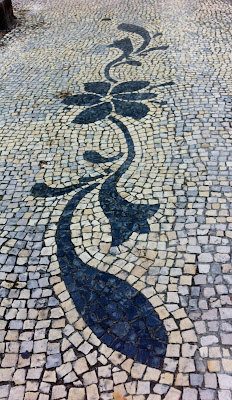 |
| Cobbled creativity |
 |
| Graffiti, Porto-style |
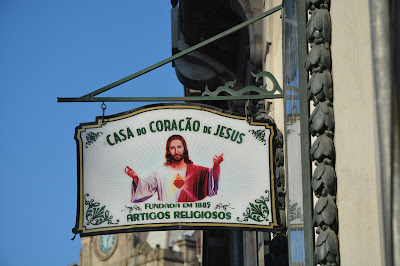 |
| A Jesus Shop |
 |
| Café on backstreet |
We ambled around the backstreets of Porto, enjoying the colours, friendly people and buildings.
This great giftshop called 'Carmelitas' is worth a visit.
 |
| Carmelitas |
 |
| Inside Carmelitas |
 |
| Porto watch-dogs |
 |
| Porto shop mannequins |
Many shops in Porto showcased their wares using these older-style mannequins. We noticed there were above the average number of shoe shops in Porto.
 |
| Add caption |
 |
| The Majestic Café |
Azulejo is a form of Portuguese painted tin-glazed ceramic tilework. Azulejos are found on the interior and exterior of churches, palaces, ordinary houses, schools, and nowadays, restaurants, bars and railways or subway stations. They were used not only as an ornamental art form, but also had a functional capacity of temperature control.
Time for Tapas! We discovered this crazy restaurant full of a collector's treasure trove.
 |
| Sharon and Sylvester at the Tapas bar |
 |
| Sao Bento train station |
 |
| Porto time |
 |
| Wedding in a Train Station |
 |
| Porto on Douro |
 |
| We love Porto |
 |
| Wrought-iron |
We took an afternoon out to Filipa' stomping ground of Antas, home to Porto's football team FC Porto.
 |
| Cristal Palace gardens |
Our final stop was for four nights in Evora in the heart of Portugal. Évora is home to St Francis Church and its famous Chapel of Bones, where the remains of more than 5,000 of Évora’s past inhabitants are cemented to the walls of this large, eerie sixteenth-century tomb, created by a group of Franciscan monks.
 |
| Tomb of 5000 bodies |
The creepiest sight is what looks like the desiccated corpse of a child, hanging off to the right of the entrance, where a sign reads "
Nós ossos que aqui estamos, pelos vossos esperamos," meaning "We bones that are here, await yours."
It is home, too, to the Temple of Diana, one of the best-preserved Roman temples remaining on the European mainland, dating back to 200BC.
 |
| Temple of Diana |
 |
| View from Se Cathedral |
The Sé Cathedral name is derived from the two letters S and E, which in Latin stands for Sedes Episcopalis (the seat of the bishop); therefore, the Sé de Evora is the Bishop’s seat in Evora. The most historically important event occurred in the Sé was the blessing of Vasco da Gama’s fleets flags before his famous expedition to India. In 1988, the cathedral was classified as a World Heritage Site by UNESCO.
 |
| Another peaceful place |
 |
| Se Cathedral with large Rose window |
 |
| I've seen more gold than I've had hot dinners.. |
 |
| Cathedral built 1186 |
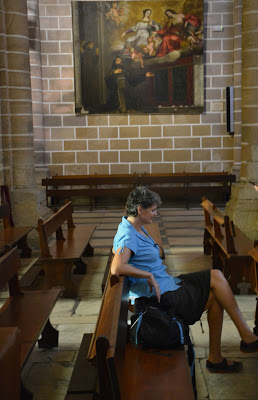 |
| A moment of reflection |
One of the highlights from my visit to the Cathedral was sitting quietly with an attitude of Thankfulness when the elderly couple in front of me burst into gentle but strong, choir-perfect singing. Just a blessed moment.
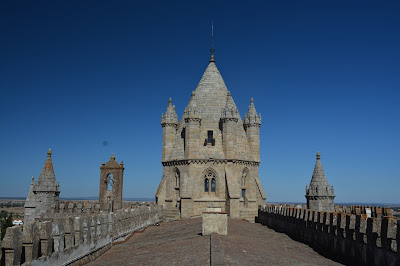 |
| And Jeroen was stomping around on the roof! |
 |
| A stunning day in Evora |
 |
| Jesus on every corner |
 |
| Evora restored |
The Praca do Giraldo, once an execution site during the inquisition with it's fountain built in mid 1500.
 |
| Evora cork tree region |
 |
| Stone monolith (lone standing stone) |
The construction of these structures date back to the 6th millennium BC. The Cromlech of the Almendres complex is the largest existing group of structured menhirs (standing stones) in the Iberian Peninsula, and one of the largest in Europe. These are sites of ancient religious ceremonies, sometimes containing burial chambers although the exact function of menhirs is debatable.
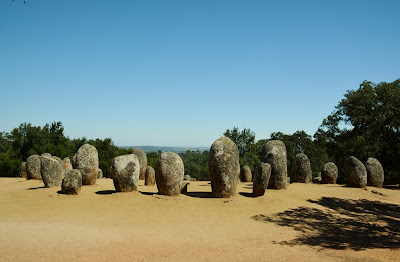 |
| Stone circle near Evora |
Following 3 weeks in Portugal we spent one night in Brussels, Belgium en route to Luanda.
Now back to the city where you can park your car across pedestrian crossings and the pedestrians cross on anything other than crossings, stopping at red traffic signals is a choice and the street boys claim any public spaces which are a high premium for parking.
Last weekend I attended the annul LBW gala fundraising evening as the photographer.
It was a fun time dancing under the stars and meeting new people.
 |
| This couple enjoyed a dance away from the noise |
 |
| Joelle, Katie and Kelley from where I live |
 |
| Nice friends Kasia and Cynara |
 |
| The soon-to-be-married Alex and Cynara |
 |
| The Beats Boys' |
 |
| Empregadas das mesas |
 |
| Small portion of canapes |
 |
| Jack and the girls' |
September 27, I went out on the boat today to spot whales...look what we saw!
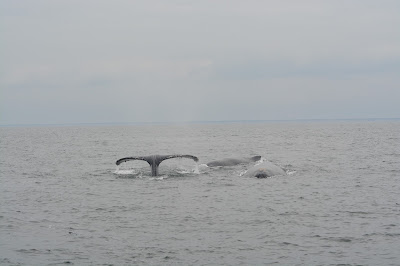 |
| 3-4 whales at a time circled us |
 |
| Barnacles and all |
 |
| Goodbye for now |
We also saw some other friends on another boat who told me that after we left, the whales began dancing and leaping and turtles came along...
 |
| Jill and John from embassy with friends |
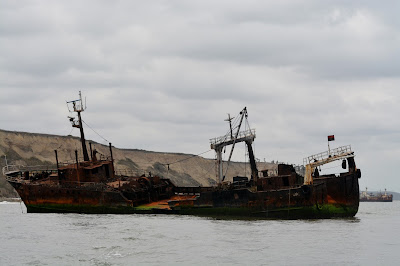 |
| back to Shipwreck beach |
 |
| Out on the boat with Joelle and Adrian |
Photo from Jill today who was on other boat...
 |
| Curious whales |




































































































































































































